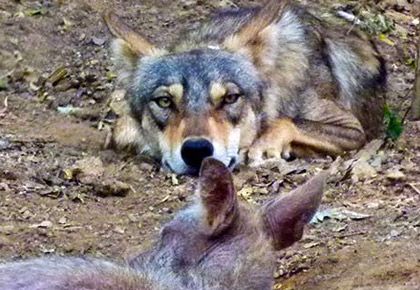Studying wolves' howls could reveal how human language evolved.
Ankur Paliwal reports.
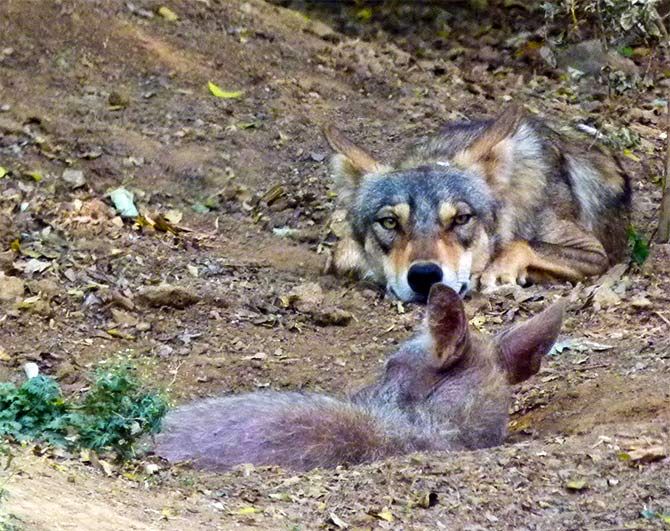
IMAGE: Although wolves share the same vulnerability status as tigers in India, there is no government project to protect wolves, whose numbers biologists believe are declining.
An Indian wolf in the Mysore zoo. Photograph: Kind courtesy L Shyamal/Wikimedia Commons
At 5 am on a not-so-cold January morning this year, Bilal Habib, a scientist at the Wildlife Institute of India, parked his jeep near a watch tower in the Nannaj grasslands, east of Mumbai.
He and four others of his team climbed the tower. There, Habib took out a portable speaker and a recorder from his bag. He played a pre-recorded howl of a wolf for 30 seconds, and waited for a minute for wolves that might be around to respond.
There was no response.
He played the howl again.
No response.
He played it a third time.

IMAGE: A wolf pack preparing to hunt at the Blackbuck National Park, Gujarat. Photograph: Kind courtesy Vickey Chauhan/Wikimedia Commons
A wolf responded with a resounding howl, which the recorder captured.
Habib's team descended the tower smiling, started their jeep and drove away to record more howls.
This way Habib's team has recorded over 500 howls from 30 sites in Maharashtra in the last two years.
"Each wolf has a distinct howl," Habib tells me. "Like the stripes of a tiger."
He is building a database of howls, which he analyses using computer software to understand how each is different from the other.
The idea is to use howls to estimate wolf populations.
"A major lacuna in wolf conservation is that we don't have numbers," says Habib. "And there is no mechanism to estimate them."
Although wolves share the same vulnerability status as tigers, there is no government project to protect wolves, whose numbers biologists believe are declining.
After cheetahs, which are now extinct in India, wolves are the top predator in grasslands.
A pack of wolves could have four to 12 individuals and roams large distances, sometimes covering up to 400 sq km in Maharashtra, Gujarat, Madhya Pradesh, Uttar Pradesh, Andhra Pradesh, Karnataka and parts of the Himalayas.
Wolves howl to reunite with their pack, mark their territory, and to defend themselves.
Scientists say the database of wolf howls can be used to study many other things including how human language evolved.
Habib is advancing a 2016 multi-country study, led by zoologist Arik Kershenbaum of the University of Cambridge.
In the study, Habib and researchers from the United Kingdom, the United States and Spain recorded about 2,000 howls from 13 different species of the canidae family, including wolves, jackals, foxes and dogs.
The study showed that each species has a specific 'vocal fingerprint'.
That prompted Habib to think that each wolf could have a specific howl too.
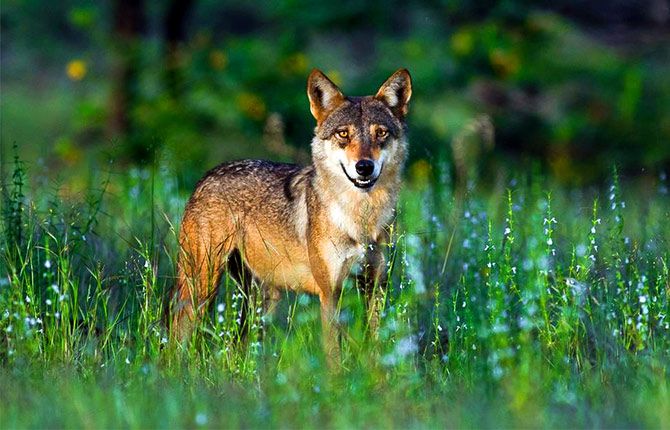
IMAGE: A fine specimen at the Mayureshwar Wildlife Sanctuary, Pune. Photograph: Kind courtesy Rudraksha Chodankar/Wikimedia Commons
Habib explains that, like humans, each wolf has its own voice or a repertoire.
This repertoire is made of several kinds of sounds, such as howl, growl, whimper, yelp, bark, woof and snarl.
"Howls are the easiest to study," says Habib.
Wolves have the longest-ranging howl among terrestrial animals. They use it to communicate over long distances.
Habib keys the howls that he collects into software in his computer that shows how each howl is different in terms of its pitch, frequency, amplitude and other such parameters.
As challenging as it may sound, Habib is also trying to record all probable variations of the wolf howl.
He has achieved about 80 per cent accuracy in relating a specific howl to a specific wolf.
He is also recording other sounds of a wolf's repertoire to see if these too are unique for each wolf.
Grasslands have been shrinking over the years, mostly due to urbanisation, irrigated agriculture and overgrazing.
This is because grasslands, especially in the semi-arid or partially dry regions, have always been ignored by the government, says Abi Tamim Vanak, associate professor at the Ashoka Trust for Research in Ecology and Environment in Bengaluru.
Most grasslands are termed wasteland by the government, and are not protected under any policy.
This leaves them open for exploitation, says Vanak who recently mapped semi-arid grasslands covering about 5 per cent of the total area in 11 states.
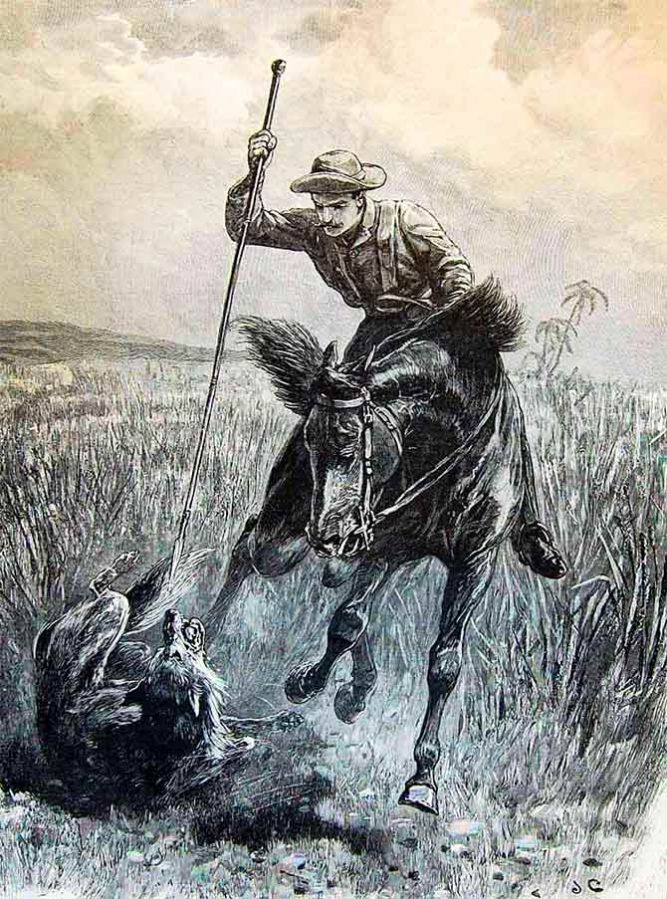
IMAGE: An engraving of a hunter on horseback spearing a wolf on a hunt in India in 1895. Sketch: Kind courtesy The Graphic/Wikimedia Commons
Grasslands have shrunk by about 40 per cent in the last century, Vanak estimates. There is no estimate of the total grasslands in India.
As cities expand, real estate is the biggest threat to semi-arid grasslands.
Then, there is the forest department that is on a spree to plant commercial and exotic species in grasslands.
All this leads to shrinking space affecting a myriad species, including wolves' prey -- chinkara, black buck, goats and sheep.
Habib observes that an area in Nannaj than supported two packs of wolves about eight years ago now holds only one pack because the villages have grown and a four-lane highway was built through it.
"Wolves are under tremendous pressure and can adapt only to an extent," says Habib.
Kershenbaum, who led the multi-country study, reckons the database of howls can be used to track wolves, manage their population, and to minimise their conflict with humans.
For example, playbacks that imitate territorial markings can be used to dissuade wolves from coming close to farms and livestock.
Kershenbaum also points at studying the howls of wolves may help us understand how human language evolved.
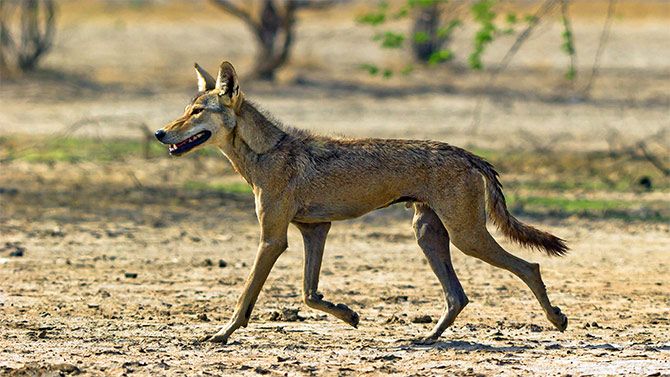
IMAGE: Wolves can be found in Maharashtra, Gujarat, Madhya Pradesh, Uttar Pradesh, Andhra Pradesh, Karnataka and parts of the Himalayas. This wolf is seen at Velavadar in the Blackbuck National Park, Gujarat. Photograph: Kind courtesy Dhaval Vargiya/Wikimedia Commons
Social species such as wolves and dolphins have a range of communicative strategies.
So, if these and other predators adopted particular strategies to hunt together more effectively, it is possible that our human ancestors did something similar, he adds.
"We can try to reconstruct likely evolutionary pathways to language," says Kershenbaum.
Habib agrees. He is interested in using the database to study whether wolves in human-dominated areas begin to howl less over time.
"It is said that there is extinction of behaviour before extinction of the species," says.
